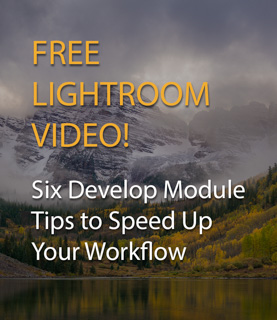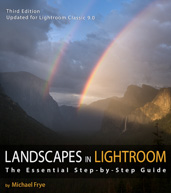In the Moment:
Michael Frye's Landscape Photography Blog
by Michael Frye | Jul 12, 2011 | Composition, Photography Tips, Vision and Creativity
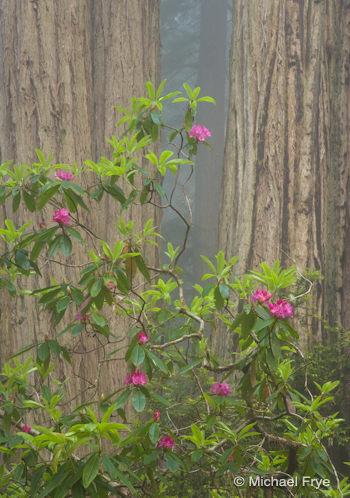
Redwoods and rhododendrons—telephoto view
A Tale of Two Photographs
Reading David duChemin’s eBook A Deeper Frame got me thinking about how we perceive depth and space in photographs, and how lens choice affects that perception.
David says that because photography turns “a world of three dimensions into two,” that “if we aim to create photographs that create within the reader a deeper, fuller, longer experience, it falls to us to recreate that depth.”
There’s no question that wide-angle lenses are better tools for creating a sense of depth in a photograph than telephoto lenses. Telephotos make objects appear closer together than they really are, compressing space and flattening the perspective. Wide-angle lenses make objects appear farther apart than they really are, expanding the sense of space, and, if used correctly, creating an illusion of depth.
These two photographs from my recent trip to the redwoods illustrate the difference. Both images include the same rhododendrons and redwoods.
In the top image I stepped back with a telephoto lens (130mm) and isolated part of the bush against two redwood trunks. It looks like the rhododendrons are only a few feet in front of the trees, but they’re not. They’re at least 20 feet away—illustrating the compression effect of the telephoto lens. The sense of depth is minimal.
(more…)
by Michael Frye | Jul 8, 2011 | Photography Tips
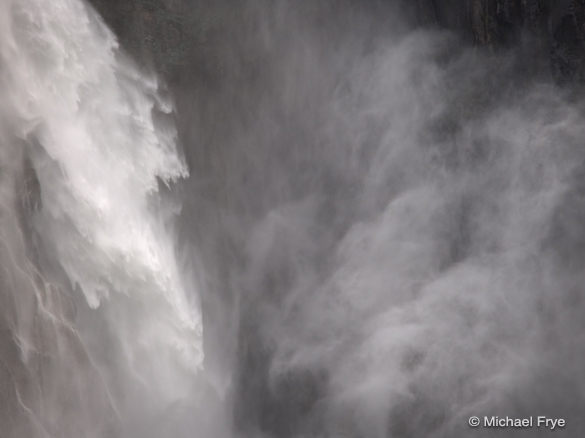
Cascade Fall, Version 1
Living near Yosemite I often photograph moving water—big, thundering waterfalls, small cascades, and everything in between. If you watched me photographing some of these scenes, you’d see me pressing the shutter over and over again without moving the camera or changing any of the settings—just click, click, click, click, click…
Am I just wasting space on my Compact Flash card? No—there’s a method to this madness. Water moves. A waterfall or river changes from one second to the next. In fact it’s never exactly the same twice. So while my composition, shutter speed, and aperture may be the same, each photograph is different, and some are bound to be better than others.
(more…)
by Michael Frye | Jun 30, 2011 | Photography Tips, Vision and Creativity

Redwoods, ferns, and rhododendrons near the northern California coast
Last week my wife Claudia and I visited our son Kevin in Arcata, California (he goes to Humboldt State University there). Arcata is just north of Eureka, along the northern coast of California, in redwood country.
Eleven years ago we’d camped in this area, and hiked a beautiful trail through the redwoods (nine-year-old Kevin complaining the whole way, especially on the steep climb back). The next morning I returned alone with my camera, found the forest enveloped in dense fog, and made one of my favorite photos ever.
I’d never gone back to that spot, but forecasters predicted patchy fog for last Wednesday morning, and it seemed like a good time to go. So we rose early and drove through fog, then sun, and back into fog. As we neared the trailhead I caught a glimpse of a roadside redwood grove that took my breath away. In the fog it was just so beautiful, so… primeval. I felt I’d traveled back in time a million years.
(more…)
by Michael Frye | Jun 29, 2011 | Reviews
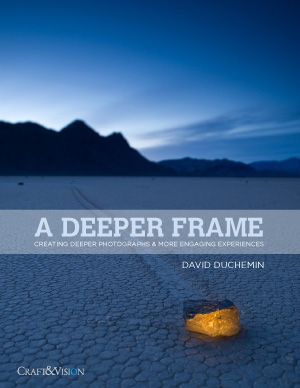
A Deeper Frame
I think David duChemin is one of the most refreshing voices in the world of photography today. While most of the photographic world seems to talk about equipment, or the latest way to make your photographs “pop” in Photoshop, David prefers to talk about vision, and emotion, and the art of photography. Radical stuff.
David, as some of you may know, is the founder of Craft & Vision, the publisher of my eBook Light & Land: Landscapes in the Digital Darkroom—as well as over twenty other eBooks. It’s been awhile since David wrote his own eBook, so I was excited to hear that he was working on a new one.
This book—A Deeper Frame—is now available, and it lives up to my high expectations for David’s writing. In this volume David examines an aspect of photography that most of us have probably thought about at one time or another: depth. But in typical fashion, David offers fresh perspectives, and (pardon the pun), a deeper look at this vital subject. He certainly got me thinking with passages like this:
The more a photograph recreates the illusion of reality as we experience it, the deeper the potential experience, the longer the memory of the image, the greater the possible impact on their hearts and minds. Deeper photographs give us a means to create more engaging one-frame visual stories.
Of course there’s also plenty of more practical advice about how to create depth in your photographs, including an interesting discussion of perspective, placement of elements within the frame, optics, and focus. Then he moves on to some less-obvious ways to create depth through color and light.
If there’s one thing missing from this volume, it’s how to flip this concept around: to deliberately flatten the perspective in a photograph—something I do frequently. Maybe I’ll post something about that here in the future. But in the meantime, I highly recommend you read this eBook. If nothing else it will get you thinking about the whole concept of depth in photographs, something that most of us—myself included—pay too little attention to.
As always, this Craft & Vision eBook is only five dollars. What’s more, until midnight, July 2nd, you can get A Deeper Frame for $4 (discount code DEEP4). Or you can buy 5 eBooks (including Light & Land, if you don’t already own a copy!) for the price of 4 (discount code DEEP20). And, for the first time, an even bigger volume discount: 12 eBooks for $40. Use discount code DEEPER12.
by Michael Frye | Jun 22, 2011 | Yosemite Photo Conditions
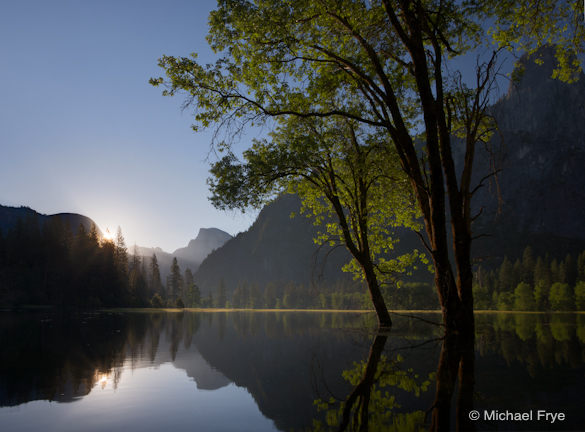
Half Dome and oaks in flooded Leidig Meadow, June 16th
Last Thursday Claudia and I rose early and drove up to Yosemite Valley to see the high water. When we arrived, we found Swinging Bridge almost completely submerged, and large portions of Leidig and Chapel meadows resembled lakes.
I wanted to make a photograph that “said” high water—that really showed the flood. But when the water is this high, many of the best viewpoints are under water! I found a spot in Leidig Meadow that looked great, with two of my favorite Yosemite Valley oaks rising out of the pond. But there was no way to photograph these trees from dry ground without contending with intervening branches and trunks. If I wanted this photograph, I’d have to wade in.
(more…)
by Michael Frye | Jun 20, 2011 | Yosemite Photo Conditions
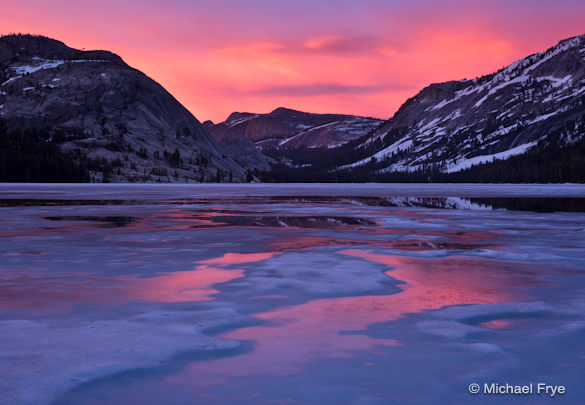
Sunset at Tenaya Lake, Saturday evening
Tioga Pass opened Saturday, making the Yosemite high country accessible again. We always like to see this terrain when it’s still covered in snow—a taste of winter in May or even June—so Claudia and I drove up on Saturday afternoon. There was a lot of snow, but based on reports we heard during the last two weeks we actually expected more. The recent warm weather has melted the snowpack quickly. But, as you can see from the short video below, we found some large snow banks, and Tenaya and Tioga Lakes were still mostly frozen.
Skies became increasingly overcast Saturday afternoon, so I photographed abstract patterns and subtle colors in the ice at Tenaya Lake, not expecting much of a sunset. But late in the day I noticed a hint of purple in the clouds, and soon the sky exploded into shades of red, allowing me to capture the image at the top of this post.
(more…)
by Michael Frye | Jun 17, 2011 | Critiques
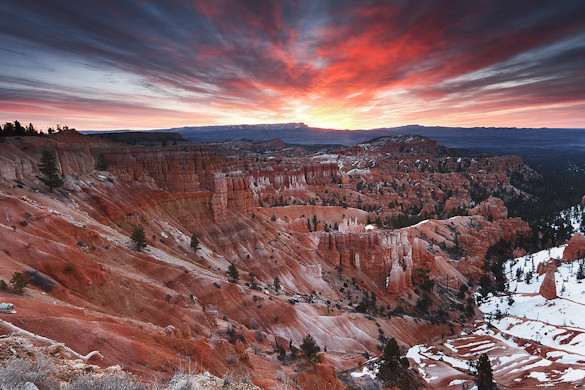
"Sunrise From Sunset Point" by Raymond
The critiques are back! With my trip to Utah, and then having to restore the blog, it’s been awhile, but I’m happy to be able to present another photo critique this week, and I hope it won’t be so long until the next one. Thanks for your patience!
Light
This week’s photograph was made by Raymond in Bryce Canyon National Park, Utah. Perhaps the most striking feature of this image is the colorful sky, with clouds appearing to radiate out from the sun just before it clears the horizon. The warm hues of the red-orange clouds, along with the rusty rocks, form a nice color contrast with the cool blues of the sky and distant mountains.
Composition
What I like most about this composition is how the foreground and background complement each other. Those radiating lines in the clouds are subtly echoed by the folds in the landscape below.
Raymond said, “I found the scene to have many things going on—the snow, the hoodoos, the colored bands across the canyon sides, the ridges running down the sides, etc. In circumstances like that I find it difficult to feel “sure” of how the elements are arranged. I basically placed the horizon at the one-third point and placed the sun at the left/right midpoint. With my fingers crossed, I was hoping the colored bands would help lead the eye into the distance and the canyon’s bowl-like shape to cradle the elements of the scene.”
(more…)
by Michael Frye | Jun 15, 2011 | Yosemite Photo Conditions

Abundant mist created an exceptionally wide lunar rainbow on Upper Yosemite Fall last night.
The National Park Service announced today that Tioga Pass will open this Saturday at 8 a.m. Last year the high country still held tons of snow on opening day, and it was wintry and beautiful. It sounds like there’s even more snow this year, and I’m looking forward to seeing it!
Meanwhile, the warmest temperatures of the year have created minor flooding in Yosemite Valley. The highest water levels are expected tomorrow morning, and Swinging Bridge will probably be underwater. Some road closures are possible, and some campsites may be evacuated (perhaps already have?), but it looks like there won’t be any major closures in the near future. However, there’s still plenty of snow at higher elevations, and hot weather is expected to return in the middle of next week, so it seems likely that we’ll see more minor flooding by next Wednesday or Thursday.
(more…)
by Michael Frye | Jun 13, 2011 | Yosemite Photo Conditions

Misty sunrise from Tunnel View, 6/6
After a long, cool spring, the weather in Yosemite has finally warmed up. Increasing snowmelt has raised the volume of the waterfalls, and partially flooded the meadows. And it’s supposed to get warmer: temperatures are predicted to reach eighty or above tomorrow and Wednesday. The waterfalls will only get bigger, and the meadows will turn into giant reflecting ponds. The Merced River is expected to reach flood stage by tomorrow night, and peak early Thursday morning. Flooding will probably be minor, but road closures are possible.
All this happens at just the right time for people hoping to photograph the lunar rainbow during the upcoming full moon. Once again, here’s a link to Don Olson’s site with his predictions for when the moonbow will be visible from the bridge below Lower Yosemite Fall, and from Cook’s Meadow. Note that the lower fall will probably be much too wet for photography—it will be impossible to keep spray off the lens. Also, here’s a link to one of my previous posts with tips for photographing this event.
(more…)
by Michael Frye | Jun 9, 2011 | Photography Tips
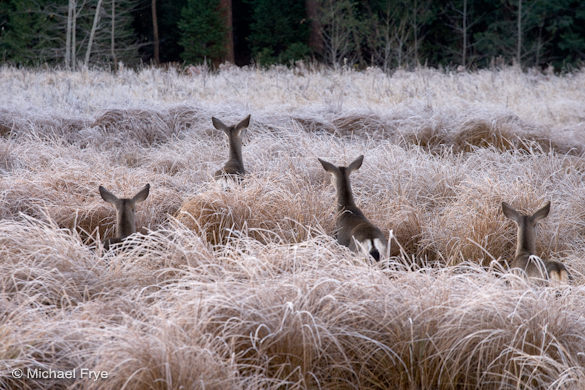
Sometimes it's easy to pick the winners—they just jump out at you, like this image did when I first saw it on my screen. But usually editing is a more difficult task.
First of all, thanks to everyone who commented on my post from last Friday. Your participation is such a vital part of this blog, and makes it more fun for me, and everyone else.
Of the three dogwood images I posted, “C” was clearly the favorite. But there were some strong votes for A and B as well. Just another example of how subjective photography is!
It’s also an example of how difficult it can be to edit your work. When I ask students to bring a portfolio of ten images to a workshop, they often tell me how hard it was to narrow it down to such a small selection. Many have never had to do that before.
But editing—and I mean this in the traditional sense of selecting images, rather than processing or developing them—is one of the most important aspects of photography.
(more…)











